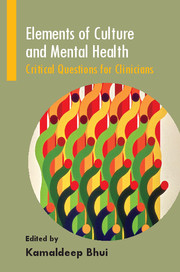Book contents
- Frontmatter
- Contents
- List of contributors
- Foreword: Desire and commitment: essential ingredients in learning about culture and mental illness
- 1 Is trauma-focused therapy helpful for survivors of war and conflict?
- 2 Will ethnopsychopharmacology lead to changes in clinical practice?
- 3 Does cognitive–behavioural therapy work for people with very different cultural orientations and backgrounds?
- 4 Can you do meaningful cognitive–behavioural therapy through an interpreter?
- 5 Are particular psychotherapeutic orientations indicated with specific ethnic minority groups?
- 6 Can psychotherapeutic interventions overcome epistemic difference?
- 7 On the role of culture and difference in evaluation, assessment and diagnosis
- 8 Necessary and sufficient competencies for intercultural work
- 9 On the validity and usefulness of existing Eurocentric diagnostic categories
- 10 Benefits and limitations of the cultural formulation in intercultural work
- 11 Barriers to the intercultural therapeutic relationship and how to overcome them
- 12 How does intercultural interpretation work in the mental health setting?
- 13 Do the power relations inherent in medical systems help or hinder in cross-cultural psychiatry?
- 14 Recovery and well-being: a paradigm for care
- 15 Social perspectives on diagnosis
- 16 Public mental health and inequalities
- 17 Can you do psychotherapy through an interpreter?
- 18 Can race and racism be acknowledged in the transference without it becoming a source of therapeutic impasse?
- 19 Cultural competence: models, measures and movements
- 20 Religion, spirituality and mental health
- Index
2 - Will ethnopsychopharmacology lead to changes in clinical practice?
Published online by Cambridge University Press: 01 January 2018
- Frontmatter
- Contents
- List of contributors
- Foreword: Desire and commitment: essential ingredients in learning about culture and mental illness
- 1 Is trauma-focused therapy helpful for survivors of war and conflict?
- 2 Will ethnopsychopharmacology lead to changes in clinical practice?
- 3 Does cognitive–behavioural therapy work for people with very different cultural orientations and backgrounds?
- 4 Can you do meaningful cognitive–behavioural therapy through an interpreter?
- 5 Are particular psychotherapeutic orientations indicated with specific ethnic minority groups?
- 6 Can psychotherapeutic interventions overcome epistemic difference?
- 7 On the role of culture and difference in evaluation, assessment and diagnosis
- 8 Necessary and sufficient competencies for intercultural work
- 9 On the validity and usefulness of existing Eurocentric diagnostic categories
- 10 Benefits and limitations of the cultural formulation in intercultural work
- 11 Barriers to the intercultural therapeutic relationship and how to overcome them
- 12 How does intercultural interpretation work in the mental health setting?
- 13 Do the power relations inherent in medical systems help or hinder in cross-cultural psychiatry?
- 14 Recovery and well-being: a paradigm for care
- 15 Social perspectives on diagnosis
- 16 Public mental health and inequalities
- 17 Can you do psychotherapy through an interpreter?
- 18 Can race and racism be acknowledged in the transference without it becoming a source of therapeutic impasse?
- 19 Cultural competence: models, measures and movements
- 20 Religion, spirituality and mental health
- Index
Summary
There is much evidence of a variation in the response to psychotropic medications across different ethnic groups, and there are many explanations for this phenomenon. In general, these explanations span three intersecting domains.
The first domain is that related to genetics. Certain patterns of genetic polymorphisms are more or less prevalent in particular ethnic groups. These polymorphisms are known to cause variations in the biological processes underlying the pharmacological actions of psychotropic drugs. The processes of drug metabolism are the primary research area. The second domain relates to the interaction between human biology and the wider environment. For example, enzymes that operate within metabolic pathways can be modulated by factors such as diet, alcohol usage, nicotine, illicit drug use and the use of alternative/complementary therapies. The third domain relates to variations in the expression of mental illness across cultures and ethnicities. This can lead to misdiagnosis, mistreatment and a variation in perceived treatment response. These three domains do not provide a complete explanatory model, but they go some way towards an understanding of the biopsychosociocultural context of psychopharmacotherapy.
This chapter will concentrate on the first domain, that of genetics. I shall start by introducing three areas of scientific endeavour: pharmacogenetics, pharmacokinetics and pharmacodynamics. These three disciplines, taken together in the context of culture and ethnicity, describe the developing field of ethnopsychopharmacology. Pharmacogenetics is the investigation of the genetic factors that influence an individual's reaction to a drug (Arranz et al, 2007). Pharmacokinetics is the determination of what happens to the drug in the body; this includes its absorption, distribution, metabolism and excretion. Pharmacodynamics is the study of the biochemical and physiological processes that form the basis for the pharmacological action of a drug, which includes the desired therapeutic effects and the undesired side-effects. The processes involved are complex and often incompletely understood.
Most pharmacogenetic and pharmacokinetic research has focused on the genes encoding the drug-metabolising enzymes. Nearly all psychotropic drugs are metabolised by the cytochrome P450 (CYP) enzymes in the liver (notable exceptions include lithium and lorazepam). The enzymes primarily responsible for psychotropic drug metabolism include CYP1A2, CYP2C19, CYP2D6 and CYP3A4.
- Type
- Chapter
- Information
- Elements of Culture and Mental HealthCritical Questions for Clinicians, pp. 7 - 11Publisher: Royal College of PsychiatristsPrint publication year: 2013

